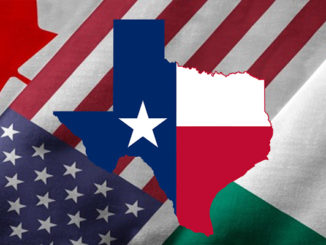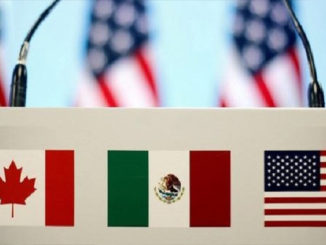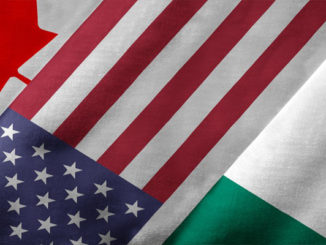by William Alan Reinsch
The Trump administration announced on Monday that it has reached a “preliminary agreement in principle” with Mexico over bilateral issues in the renegotiation of the North American Free Trade Agreement (NAFTA). The president also announced that he intends to terminate the existing NAFTA deal and will start negotiations with Canada soon. U.S. Trade Representative Robert Lighthizer said he expects to finalize a deal which he hopes will include Canada by the end of the week. The U.S.-Mexico announcement comes over a year after the renegotiation began and signals progress in the administration’s first substantive trade negotiation. What is the status of the NAFTA negotiations after this development and what’s worth watching?
Q1: Has NAFTA been completely renegotiated? Is it a bilateral U.S.-Mexico agreement now?
A1: No, a new NAFTA deal has not been struck, and the trilateral agreement has not become a bilateral deal between the United States and Mexico. The Trump administration has only announced a “preliminary agreement in principle” with Mexico on a subset of issues at play in the overall NAFTA negotiations. The U.S.-Mexico deal is not legally binding and does not replace NAFTA. Even though this bilateral arrangement has been announced, both President Trump and Mexican President Enrique Peña Nieto said on Monday during a phone call with Trump that Canada should rejoin the NAFTA talks. The Canadian administration has also expressed a keen interest in returning to the talks.
NAFTA is made up of three countries—Canada, Mexico, and the United States. While the United States and Mexico have now worked out some issues amongst themselves, the third leg of the stool hasn’t been present for months. Canada has yet to rejoin the talks and still has priorities of its own and disagreements to hammer out with the United States and Mexico.
Q2: But didn’t President Trump say he’s ending NAFTA and that he would split the agreement into two bilateral deals?
A2: It appears that the administration will proceed under the assumption that NAFTA will ultimately remain a trilateral deal, although President Trump and Trade Representative Robert Lighthizer sent mixed messages on Monday. NAFTA remains a trilateral agreement and breaking it into two deals could be politically and legally difficult. President Trump did say he will terminate NAFTA in the future but suggested that he would do so to create pressure on Congress to back whatever agreement he presents to them. Trump also said he wants to ditch the NAFTA name and touted a “U.S.-Mexico Trade Agreement.” But Trump has not formally initiated U.S. withdrawal from NAFTA, has not reached or signed a legally binding agreement with Mexico, and said on Monday that negotiations with Canada would begin “almost immediately.” Lighthizer, however, did threaten to submit a congressional notice of a deal just with Mexico by Friday if a deal with Canada is not done. Canada could join the U.S.-Mexico deal at a later date, Lighthizer said.
Splitting NAFTA into two separate deals could also arguably change the legal status of the negotiations in the United States, which could complicate the administration’s chances of striking deals with Canada and Mexico and getting them approved by Congress. In the current NAFTA negotiations, the administration has met the requirements laid out under the Trade Promotion Authority (TPA) law. Lighthizer on Monday said he would not have to send new notifications under TPA to cover separate negotiations and deals with Canada and Mexico, but that claim is likely to be contested. TPA sets out congressional negotiating objectives for the administration but limits Congress to just an up or down vote on the final agreement. Under TPA, Congress cannot amend the agreement that the president submits. This creates certainty for U.S. negotiating partners and U.S. negotiators by ensuring what is agreed to is not changed by Congress at the last minute. Dividing NAFTA into two separate deals could require the administration to restart the lengthy TPA process for the two separate negotiations with Canada and Mexico or forgo it and risk changes to the deals by Congress that Canada and Mexico might not accept.
Q3: What was agreed between the United States and Mexico on autos?
A3: The most-watched and most important agreement reached between the two is on automotive rules of origin. The new agreement requires that 75 percent of auto content be made in the United States and Mexico for cars to be traded with zero tariffs. Under the current NAFTA agreement, 62.5 percent of auto content has to be made in the NAFTA region to qualify for zero tariffs among the three countries. The United States and Mexico also agreed to stronger rules of origin for industrial products such as chemicals, steel-intensive products, glass, and optical fiber.
Similarly, to qualify for zero tariffs, U.S. and Mexican negotiators agreed that 40-45 percent of the labor required to assemble cars must be made by workers earning at least $16 per hour. This is seen as a major win for both the United States and Canada who have complained about low Mexican wages that undercut U.S. or Canadian workers. Likewise, the Mexican President-Elect, Andrés Manuel López Obrador (known as AMLO), made raising Mexico’s minimum wages part of his campaign platform and is a potential supporter of the new wage provision.
Q4: Did the United States and Mexico agree to anything else?
A4: While automobiles were the main focus of the renegotiations, the two countries reached agreements on a handful of other sectors as well. Among the most important agreements is an annex to the Labor chapter which requires Mexico to take legislative actions that allow for effective recognition of the right to collective bargaining. Democrats and labor groups in the United States have fiercely complained about the lack of these provisions in the past. They claim that the lack of collective bargaining in Mexico undermines unions there, prevents wage growth, and makes it impossible for U.S. workers to compete with Mexican workers. The Office of the U.S. Trade Representative (USTR) highlighted the fact that labor obligations would be in the core of the new agreement, rather than in a side letter. This, according to the USTR, “makes [labor obligations] fully enforceable.”
The United States and Mexico updated the Market Access chapter in the original NAFTA agreement and added a new Textiles chapter for U.S.-Mexico trade. The two countries agreed to biotechnology standards for agricultural products and sectoral annexes that go beyond what had been agreed to in the original Trans-Pacific Partnership (TPP). The countries also reached agreements on rules covering financial services, the environment, digital trade, geographic indications, and intellectual property.
Finally, as mentioned earlier, President Trump announced that the new agreement would no longer be called NAFTA. “We’re going to call it the United States/Mexico Trade Agreement,” the president said. NAFTA “has a bad connotation because the United States was hurt very badly by NAFTA for many years.” Some of the president’s critics might snicker about what appears to be a cosmetic change. But as noted above, the distinction is crucial: Will this preliminary agreement pave the way for a new U.S.-Mexico bilateral trade regime, or will the trilateral nature of NAFTA prevail?
Q5. Which issues still need to be worked out between the United States and Canada and between all three countries?
A5: The largest issue that Canada and the United States will have to hash out is market access for dairy products. Canada maintains a web of domestic support for its dairy producers that have long drawn the ire of the U.S. dairy industry, lawmakers, and the president. Canadian Prime Minister Justin Trudeau has pledged not to allow a new NAFTA deal to weaken that support even as President Trump has repeatedly hammered Canada over it. A deal on dairy is likely necessary to conclude the negotiations.
The three countries also have several disagreements to resolve, and Canada must review and accept the U.S.-Mexico if NAFTA 2.0 is to remain trilateral. The United States, Canada, and Mexico must still work out rules governing dispute settlement, investor protections, and government procurement. The United States and Mexico did work out a compromise to the five-year automatic termination sunset clause the United States had previously pushed, but that compromise will have to be approved by Canada. Instead of a five-year sunset, the deal would be reviewed after six years. If the parties are unable to agree to renew it, the deal would terminate ten years from the review. Issues raised under the review would result in an annual review every year until the problems are resolved. Additionally, relief from U.S. tariffs on steel and aluminum as well as potential auto tariffs will likely be demanded from Canada and Mexico before they agree to close a deal.
Q6: Why is there such a rush to get a deal this week? What has to be done to get a trilateral deal into force?
A6: The three countries have rushed to finalize a deal by the end of this week because of the convergence of two timelines: First, U.S. law requires the administration give Congress a 90-day notice whenever it intends to sign a new trade agreement. Second, the Mexican president-elect takes office on December 1. If a deal is not notified to Congress this week, it cannot be signed by the leaders of Canada, Mexico, and the United States until AMLO takes office. Both AMLO, as the future Mexican president’s supporters call him, and current Mexican President Enrique Peña Nieto would apparently prefer the latter sign the agreement, allowing him to take credit and providing AMLO some political cover. Once the leaders have signed the deal, their legislatures must go through domestic processes to sign it and bring it into force.
William Reinsch holds the Scholl Chair in International Business at the Center for Strategic and International Studies (CSIS) in Washington, D.C. Jack Caporal is an associate fellow with the CSIS Scholl Chair in International Business. Andrew Chatzky is an intern with the CSIS Scholl Chair.



